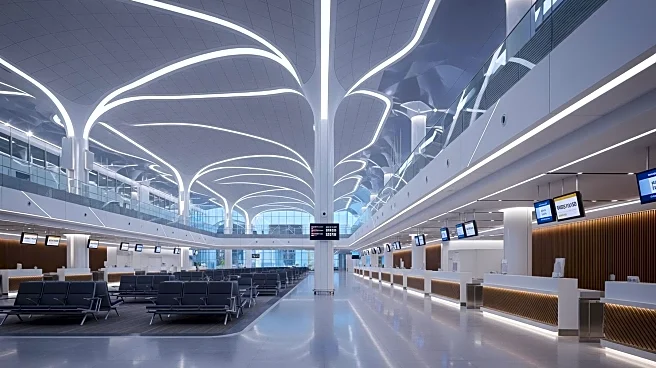What's Happening?
Pittsburgh International Airport has completed a significant $1.7 billion Terminal Modernization program, marking one of the largest airport construction efforts in the United States. The project involved
the construction of a new 811,000-square-foot terminal and a 1.1 million-square-foot parking structure, consolidating airline operations and public spaces under one roof. The development also included nearly four miles of new roadway and a 1,300-foot dual-level bridge connecting the terminal directly to the airside complex. The construction was managed by a joint venture of PJ Dick, Hunt Construction Group, and Turner Construction, with Dallas-based Jacobs serving as the program manager. Notably, the project utilized 90% of materials and labor sourced locally, and it did not rely on local tax dollars.
Why It's Important?
The completion of the Pittsburgh International Airport overhaul is a significant milestone in U.S. infrastructure development, enhancing the airport's capacity and passenger experience. The modernization is expected to boost regional economic growth by improving connectivity and attracting more travelers. The project also emphasizes sustainability, aiming for LEED Gold certification and utilizing a solar- and natural gas-powered microgrid for energy independence. This development sets a precedent for future airport projects across the country, highlighting the importance of integrating local resources and sustainable practices in large-scale infrastructure projects.
What's Next?
Following the completion of the Pittsburgh airport project, similar large-scale airport modernization efforts are underway across the United States. These include the $3 billion Terminal 1 project at San Diego International Airport and the $1.3 billion Terminal D at Chicago's O'Hare International Airport. The success of the Pittsburgh project may influence future airport developments to prioritize sustainability and local workforce engagement. Additionally, the PIT2Work apprenticeship program, which provided on-the-job training for local students, could serve as a model for workforce development in other regions.
Beyond the Headlines
The Pittsburgh airport modernization project not only enhances infrastructure but also contributes to workforce development through the PIT2Work apprenticeship program. This initiative has helped build a skilled workforce in the region, demonstrating the broader socio-economic benefits of infrastructure projects. The emphasis on sustainability and resilience in the project reflects a growing trend in construction, where environmental considerations are increasingly prioritized. The project's success may encourage other airports to adopt similar practices, potentially leading to long-term shifts in how airport infrastructure is developed and managed.













